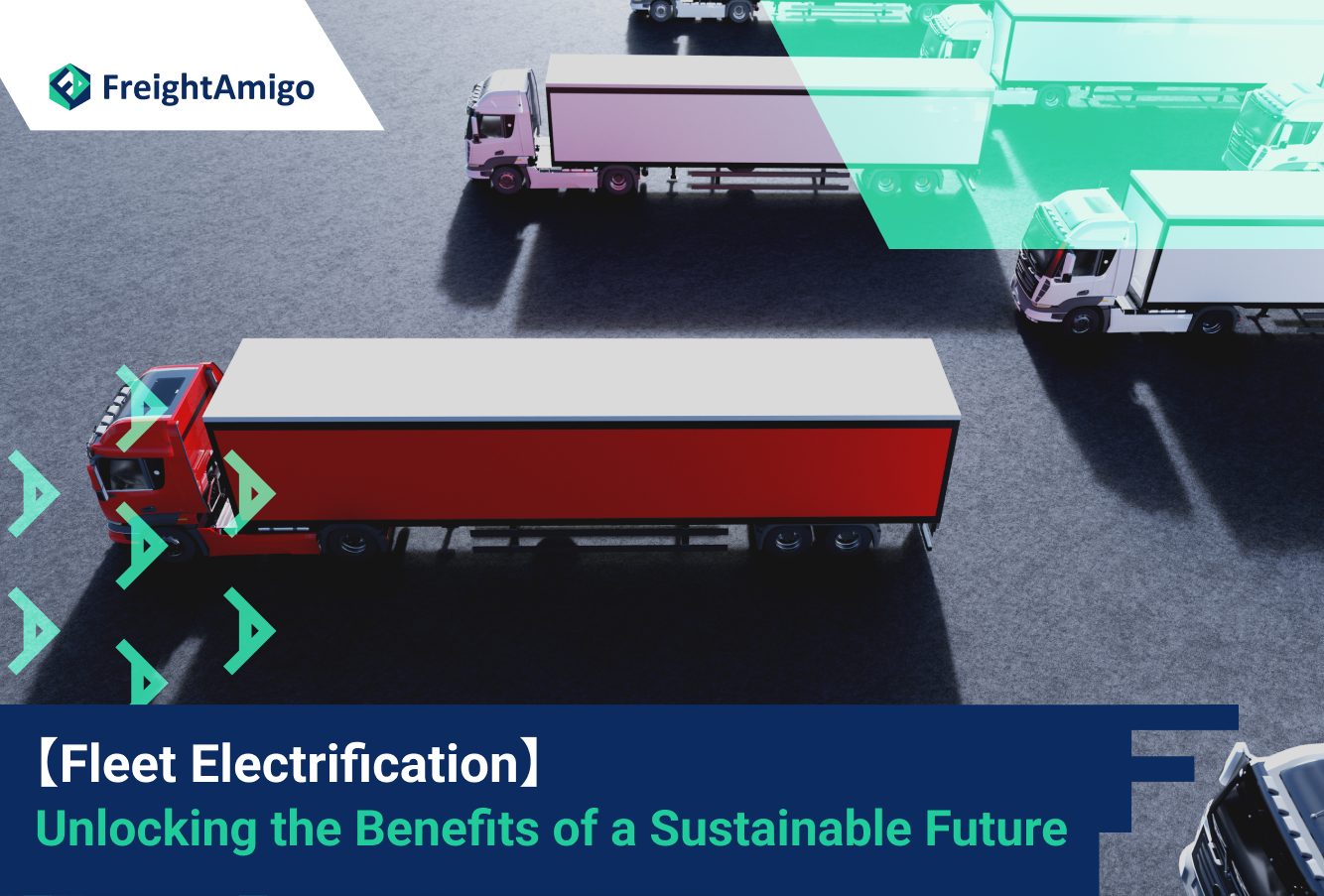Author Name: Tiffany Lee – Marketing Analyst at FreightAmigo
In the face of climate change and the urgent need for sustainability, fleet electrification has emerged as a pivotal solution. As the transportation sector remains a major contributor to greenhouse gas emissions, the adoption of electric vehicles (EVs) and the electrification of fleets by businesses and organizations play a crucial role in reducing emissions and mitigating climate change. Moreover, the benefits of fleet electrification extend beyond environmental impact, encompassing economic advantages, improved brand reputation, and even the potential for vehicle-to-grid (V2G) capabilities. In this comprehensive guide, we will explore the concept of fleet electrification, delve into its vast benefits, and address the challenges that organizations may encounter on their electrification journey.
Want To Compare The Best Express, Air Freight, Sea Freight, Rail Freight & Trucking Rates So As To Have Better Control On Cost?
Understanding Fleet Electrification
Fleet electrification entails the process of replacing traditional gasoline-powered or diesel-powered vehicles within a business or organization with electric vehicles. This transition encompasses various types of vehicles, ranging from passenger cars and trucks to buses and delivery vehicles. By embracing fleet electrification, companies can significantly reduce their carbon footprint, minimize reliance on fossil fuels, and promote a cleaner and more sustainable transportation system.
Environmental Benefits of Fleet Electrification
One of the primary advantages of fleet electrification lies in the reduced greenhouse gas emissions associated with EVs. The transportation sector heavily relies on fossil fuels, accounting for 37% of global CO2 emissions. In stark contrast to their traditional counterparts, electric vehicles produce significantly fewer emissions. On average, an all-electric vehicle emits approximately 2,817 pounds of CO2 equivalent per year, while a gasoline-powered vehicle emits a staggering 12,594 pounds. By transitioning to EVs, businesses can play a pivotal role in curbing climate change and creating a greener future.
Furthermore, fleet electrification helps to improve air quality and public health. Internal combustion engine vehicles emit pollutants such as nitrogen oxides and particulate matter, which have detrimental effects on air quality and public well-being. Notably, internal combustion engine trucks, constituting a mere 10% of vehicles on U.S. roads, are responsible for 45% of nitrogen oxide emissions and 57% of particulate matter. By adopting electric vehicles, organizations can contribute to substantial improvements in air quality, particularly benefiting communities residing near pollution hotspots.
Economic Benefits of Fleet Electrification
Beyond the environmental advantages, fleet electrification presents numerous economic benefits for businesses. Companies can achieve significant cost savings through reduced fuel and maintenance expenses. Studies have shown that electric vehicles require less maintenance due to their simplified mechanics, resulting in lower maintenance costs compared to traditional vehicles. Additionally, the cost of electricity per mile is considerably lower than the cost of gasoline, enabling substantial savings in fuel expenses. For example, the Ford F-150 Lightning consumes only $4,529 of electricity to travel 45,000 miles, while a gasoline-powered F-150 consumes $8,325 of gasoline. These cost savings can greatly benefit organizations, contributing to their overall financial sustainability.
Moreover, fleet electrification enhances brand reputation and positions companies as champions of sustainability. By demonstrating a commitment to environmental responsibility, businesses can attract environmentally conscious customers and investors who prioritize eco-friendly practices. The transition to electric fleets serves as a testament to a company’s dedication to reducing its carbon footprint and can establish long-term brand loyalty and trust. This, in turn, can drive increased revenue and market share.
Vehicle-to-Grid (V2G) Benefits of Fleet Electrification
Fleet electrification opens up opportunities for vehicle-to-grid (V2G) technology, which enables electric vehicles to serve as mobile energy storage systems. This groundbreaking technology allows EVs to store excess energy from the grid and return it during periods of high demand. By participating in V2G programs, businesses can potentially save on energy costs and generate additional revenue by selling surplus energy back to the grid. Moreover, V2G integration enhances the stability and reliability of the grid, facilitating the integration of renewable energy sources like solar and wind power.
Government Incentives and Job Growth
To accelerate the transition to clean energy and foster fleet electrification, governments worldwide offer various incentives such as tax credits, rebates, and grants. These financial incentives help offset the upfront costs associated with fleet electrification, making it more accessible for businesses of all sizes. By leveraging these incentives, companies can expedite their shift toward electric fleets, achieve long-term cost savings, and contribute to reducing carbon emissions and improving air quality.
Additionally, fleet electrification has the potential to stimulate job growth in the clean energy sector. As the demand for electric vehicles increases, new employment opportunities emerge in EV manufacturing, maintenance, and the production and distribution of electricity. According to the International Energy Agency (IEA), transitioning to clean energy is projected to create 14 million new jobs by 2030, offsetting the potential job losses in other sectors.
Challenges of Fleet Electrification
While the benefits of fleet electrification are compelling, organizations must navigate certain challenges during the transition. The upfront costs of purchasing electric vehicles can present a barrier, as electric vehicles generally have a higher initial purchase price compared to traditional vehicles. However, the long-term cost savings and advantages outweigh these initial investment challenges.
Range anxiety, the fear of running out of charge while driving, remains a concern for some businesses. Although EVs now offer longer ranges and an increasing number of charging stations exist, ensuring access to charging infrastructure remains essential, particularly in rural areas. Additionally, the limited availability of a large number of electric vehicles poses a challenge for organizations seeking to electrify their fleets. However, as EV adoption continues to rise, these challenges are gradually being addressed by manufacturers and governments.
Overcoming Challenges and Expanding Benefits with Exro Technologies
To overcome the challenges of fleet electrification and maximize the benefits, businesses can turn to innovative solutions like Exro Technologies Inc. Exro Technologies is a leading clean technology company that has developed advanced power electronics, revolutionizing the capabilities of electric motors and batteries. Their cutting-edge technologies, such as the Coil Driver™ for e-mobility and the Cell Driver™ for energy storage, bridge the performance-cost gap and accelerate the adoption of electrified vehicles.
Exro’s all-in-one EV powertrain technology addresses the performance requirements of high-demand commercial applications, enhancing operating efficiency, extending driving range, and simplifying charging infrastructure. Additionally, Exro has developed an advanced commercial and industrial energy storage system that optimizes system operation, provides backup power, and reduces business electricity expenses. Through their subsidiary, Exro Vehicle Systems (EVS), businesses can access end-to-end vehicle electrification services, capitalizing on Exro’s extensive technology portfolio and network of suppliers.
By leveraging Exro’s technology ecosystem, businesses can achieve maximum results while minimizing energy consumption. This not only offers an innovative and cost-effective solution for fleet electrification but also accelerates the environmental benefits of transitioning to electric vehicles.
Conclusion
Fleet electrification represents a powerful solution to combat climate change, reduce emissions, and promote sustainability. The environmental benefits of reduced greenhouse gas emissions and improved air quality are complemented by significant economic advantages, improved brand reputation, and the potential for V2G capabilities. Although challenges exist, organizations can overcome them through innovative technologies and government incentives. By embracing fleet electrification and leveraging solutions like Exro Technologies, businesses can unlock a sustainable future, reduce costs, and contribute to a cleaner and greener world.
There Are Different Options For Cargo Transportation. If You Want To Choose The Most Convenient And Suitable Solution, It Is Best To Have The Full Support Of Logistics Experts! If You Are Planning To Ship Goods Overseas, Please Go To The FreightAmigo Page For Inquiries.
===
Read More:
【Cosmetic Product Recycling】 A Guide to Sustainable Reverse Logistics
【Rise of Green Supply Chain】 Pioneering Sustainable Practices in Logistics
【ESG in Logistics】 How ESG Practices Drive Social Responsibility in Logistics
===
If you have any inquiries on logistics/supply chain, feel free to contact FreightAmigo now:
Chat with us online OR
Phone : +852 28121686
WhatsApp: +852 27467829









































